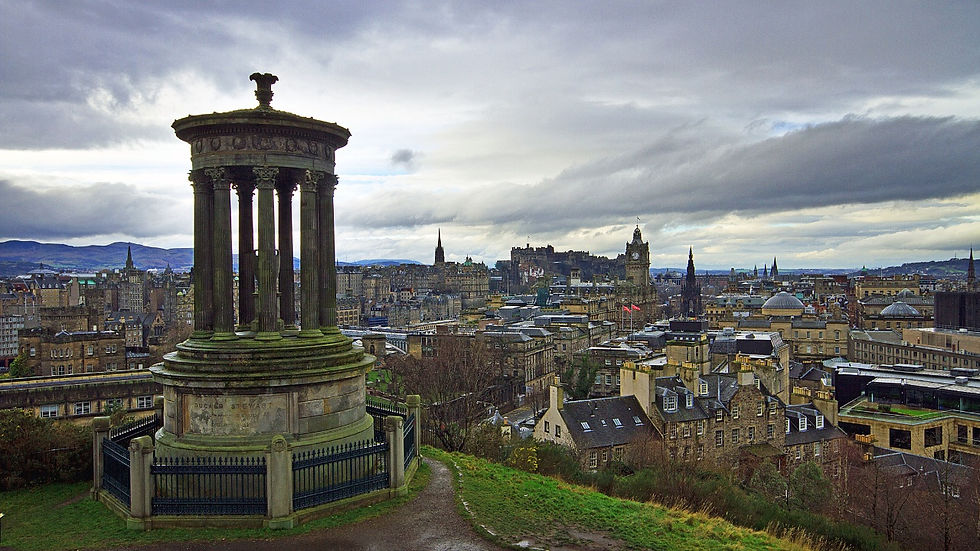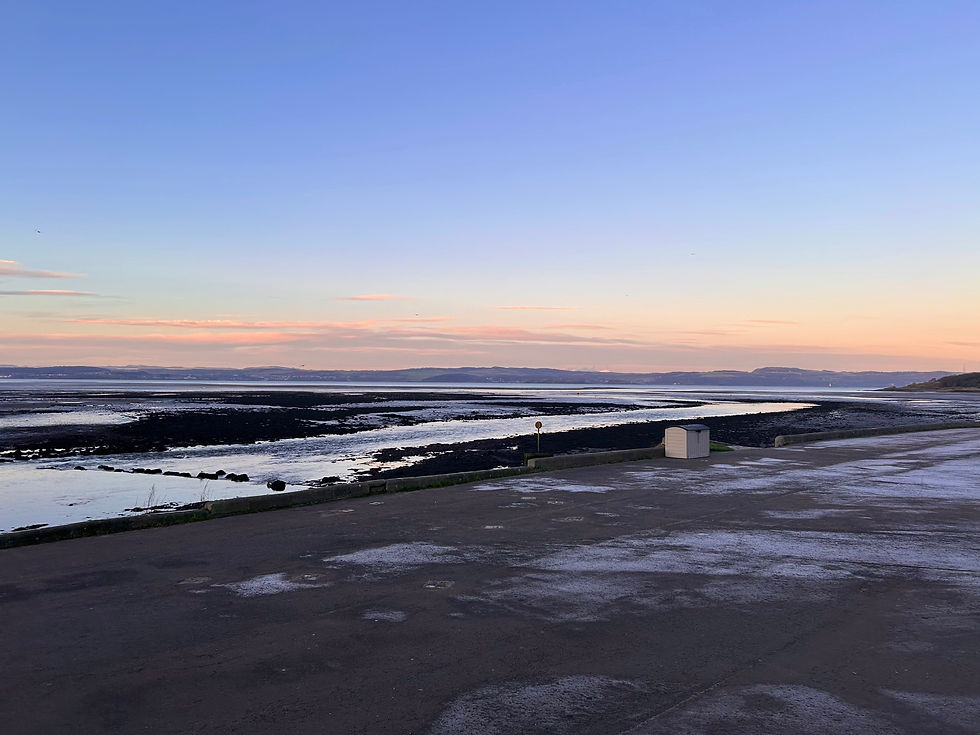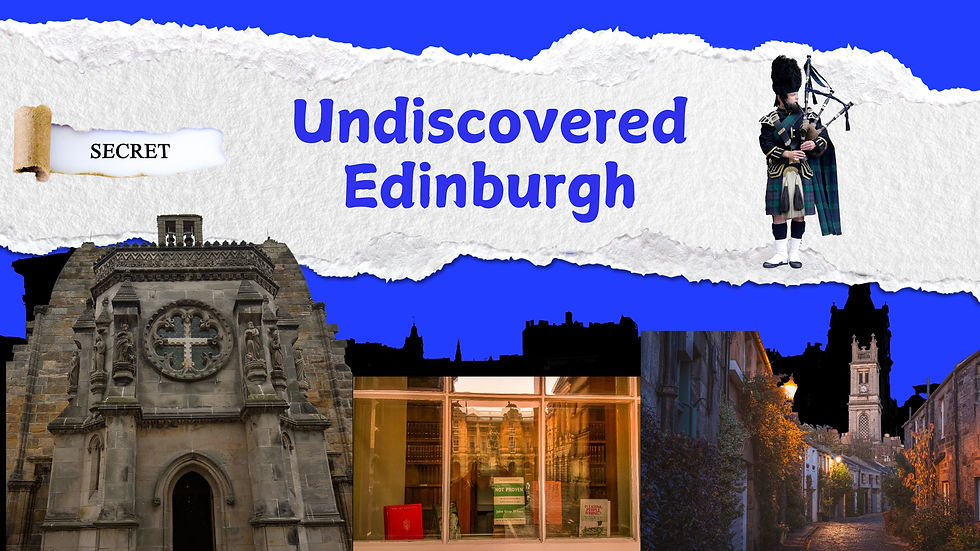Moments of Peace and Wonder: Traversing through the natural landscapes in the City of Edinburgh
- Prudence Ng

- Jan 31, 2025
- 5 min read
Updated: Feb 1, 2025

The City of Edinburgh is known for its vibrant city and student life, rich culture and the hub of artistry and history, but there are also places of quiet beauty and sublime that are lying in plain sight for tourists and residents alike to discover. During the last week of winter break, I brought my friend, who is studying at university in London (and has been dying to see the ocean after three months of torturous urban isolation), up north to show her around the natural sites of Edinburgh. We went everywhere on foot, barely ate anything on our journeys and took over 200+ photos, all of which are the most stunning natural scenery that Mother Nature has to offer. Here is a brief introduction to each location we visited and their speciality and short history, as I urge everyone studying at universities in Edinburgh to go out and explore what this city has in store for us.

1. Calton Hill
The most famous tourist destination on our journey is Calton Hill. I’ve always found the location of this hill a bit strange: it is literally a hill in the middle of the city. But unlike other hills in Edinburgh, Calton Hill holds massive cultural significance, as it is a home to many historical monuments and buildings, including the Nelson Monument, the Dugald Stewart Monument, the old Royal High School, the Robert Burns Monument and, of course, the National Monument, which are the unfinished pillars you see today from afar. Many Scottish intellectuals and artists such as David Hume, Dugald Stewart, Robert Burns, and William Henry Playfair, have their legacies marked somewhere on this hill. Their work has inspired countless others, making this hill a representation of Scottish identity.

However, even if you dismiss all the historical significance and hike up the hill, Calton Hill still does not disappoint with its scenery. Given the right moment and weather, and as long as you don’t mind the crowds and the sunlight blaring in your face, you can easily capture one of the best sunsets Edinburgh can ever give you.
2. Holyrood Park

On the snowiest day of January, we decided to challenge ourselves and hike up the hills at Holyrood Park, which, in hindsight, may not be the best idea. Although the snow is nothing compared to the snowstorm in November 2024, the hike up the mountain was tedious because of how slippery the ground was. In the end, we did reach the top of Crow Hill but couldn’t make it to Arthur’s Seat since it had already been raining heavily by the time we got back down. Despite this, something was fulfilling about reaching the top of the hill and overseeing the entire city surrounded by pure white snow.
Holyrood Park is one of the largest public parks in the City of Edinburgh, with the entire park lasting over 1.6 kilometres. It is home to many geographical and natural features, notably Arthur’s Seat and Salisbury Crags, the park’s two highest cliffs that attract many hikers. St Margaret’s Loch, the park’s artificial lake, is another site worth visiting, mainly because you can check out the cute swans, ducks and pigeons home to the lake. Aside from these natural features, many historical sites are located across the park. We discovered St. Anthony’s Chapel on the way up the hill, which is now a ruin, with an obscure past. Its location is quite eerie, too––just a rubble of fallen bricks standing in the middle of nowhere, which might add to its Gothic charm, especially when walking at night.
3. Dean Village and Water of Leith
Water of Leith is the main river in Edinburgh that lasts for 31.7 km, including a public walkway that takes tourists on a long trip through the wildlife and structures within the city. Although we didn’t start at the beginning of the walkway, we did start our journey at Dean’s Village — a historic Scottish village where the remnants of old water mills still linger in the small town. Despite the winter season having left the trees nothing but branches, the village retains its wondrous charm, especially when you admire the remnants of Dutch-style buildings from the Bell’s Brae Bridge.
While we didn’t venture far into the Water of Leith, we did capture a lot of buildings that old architects designed along the river. At one point along the walkway, we had to step on a makeshift bridge made with sheets of steel as we went under the enormous arch of Dean Bridge, marvelling at the height of the structure above us as we went past. We also stumbled upon St. Bernard’s Well, where a statue of the Greek Goddess of Health Hygeia stands, perhaps blessing the waters of Leith with healing properties just like the ponds of Lourdes. We also found at least two metal statues of naked men standing at different points of the river, which turned out to be statues sculpted by Antony Gormley as an art piece called ‘6 Times’. For ignorant tourists like us, the statues definitely weirded us out. If anyone wants to stroll through Water of Leith, be sure to keep an eye out for the little statues chilling by the water.

4. Cramond Beach and Cramond Island
Initially, we planned to visit the Lauriston Castle near Cramond, but since the castle was closed when we arrived, we sauntered around the nearby areas and stumbled upon Cramond Beach by accident. Unlike the vibrant sea-town-aesthetic that beaches like Portobello provides, Cramond Beach leans more on the natural spectrum, housing a range of birds, including Waders, Gulls, Tits, Finches, Warblers etc. Small ripples and runnels are lined across the sand, which can be challenging to navigate if you don’t wear proper boots for the journey (like us), but once you do, it is pleasant to stroll through.
Near the edge of the beach is a walkway leading to a small island in the middle of the sea, Cramond Island. The island also has a long history, with signs of human activity already present since prehistoric times. The island was then transformed into an early mediaeval stronghold, a farmland, a fishing outpost, and a fort during WWII before it was left into what it is today. Although the fort’s walls that remained on the island are now littered with graffiti, there is still a certain appeal to visiting the area, as it marks a witness to the passage of time and the people who lived before us. Unfortunately, we had to leave the island early to catch a bus back to the city centre, but if I have the time to explore more of Edinburgh, I will return to this island again and explore the other parts of history that the island has hidden from our view.

These are the places that I recommend visiting if you are studying in the City of Edinburgh. The best thing about living in Edinburgh as a student is that not only can you enjoy the diverse city life, but it also offers you time to relax and connect once again with nature, which can be very soothing for your soul, especially when handling the stress that comes with university life. Take your time on weekends to explore the City of Edinburgh’s natural wonders because, as a university student, it is always a good idea to go outside and touch some grass.





Comments